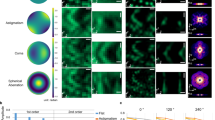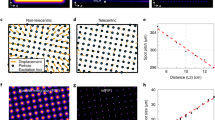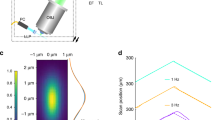Abstract
A key challenge when imaging living cells is how to noninvasively extract the most spatiotemporal information possible. Unlike popular wide-field and confocal methods, plane-illumination microscopy limits excitation to the information-rich vicinity of the focal plane, providing effective optical sectioning and high speed while minimizing out-of-focus background and premature photobleaching. Here we used scanned Bessel beams in conjunction with structured illumination and/or two-photon excitation to create thinner light sheets (<0.5 μm) better suited to three-dimensional (3D) subcellular imaging. As demonstrated by imaging the dynamics of mitochondria, filopodia, membrane ruffles, intracellular vesicles and mitotic chromosomes in live cells, the microscope currently offers 3D isotropic resolution down to ∼0.3 μm, speeds up to nearly 200 image planes per second and the ability to noninvasively acquire hundreds of 3D data volumes from single living cells encompassing tens of thousands of image frames.
This is a preview of subscription content, access via your institution
Access options
Subscribe to this journal
Receive 12 print issues and online access
$259.00 per year
only $21.58 per issue
Buy this article
- Purchase on Springer Link
- Instant access to full article PDF
Prices may be subject to local taxes which are calculated during checkout






Similar content being viewed by others
References
Lippincott-Schwartz, J. & Manley, S. Putting super-resolution fluorescence microscopy to work. Nat. Methods 6, 21–23 (2009).
Toomre, D. & Pawley, J.B. Disk-scanning confocal microscopy. in Handbook of Biological Confocal Microscopy 3rd edn. (ed., J.B. Pawley) 221–238 (Springer, New York, 2006).
Zimmermann, T., Rietdorf, J. & Pepperkok, R. Spectral imaging and its applications in live cell microscopy. FEBS Lett. 546, 87–92 (2003).
Khodjakov, A. & Rieder, C.L. Imaging the division process in living tissue culture cells. Methods 38, 2–16 (2006).
Huisken, J. & Stainier, D.Y.R. Selective plane illumination microscopy techniques in developmental biology. Development 136, 1963–1975 (2009).
Huisken, J., Swoger, J., Del Bene, F., Wittbrodt, J. & Stelzer, E.H.K. Optical sectioning deep inside live embryos by selective plane illumination microscopy. Science 305, 1007–1009 (2004).
Keller, P.J., Schmidt, A.D., Wittbrodt, J. & Stelzer, E.H.K. Reconstruction of zebrafish early embryonic development by scanned light sheet microscopy. Science 322, 1065–1069 (2008).
Durnin, J., Miceli, J.J. & Eberly, J.H. Comparison of Bessel and Gaussian beams. Opt. Lett. 13, 79–80 (1988).
Lin, Y., Seka, W., Eberly, J.H., Huang, H. & Brown, D.L. Experimental investigation of Bessel beam characteristics. Appl. Opt. 31, 2708–2713 (1992).
Garcés-Cháves, V., McGloin, D., Melville, H., Sibbett, W. & Dholakia, K. Simulataneous micromanipulation in multiple planes using a self-reconstructing light beam. Nature 419, 145–147 (2002).
Fahrbach, F.O., Simon, P. & Rohrbach, A. Microscopy with self-reconstructing beams. Nat. Photonics 4, 780–785 (2010).
Neil, M.A., Juškaitis, R. & Wilson, T. Method of obtaining optical sectioning by using structured light in a conventional microscope. Opt. Lett. 22, 1905–1907 (1997).
Gustafsson, M.G.L. Surpassing the lateral resolution limit by a factor of two using structured illumination microscopy. J. Microsc. 198, 82–87 (2000).
Keller, P.J. et al. Fast, high-contrast imaging of animal development with scanned light sheet-based structured-illumination microscopy. Nat. Methods 7, 637–642 (2010).
Botcherby, E.J., Juškaitis, R. & Wilson, T. Scanning two photon fluorescence microscopy with extended depth of field. Opt. Commun. 268, 253–260 (2006).
Riedl, J. et al. Lifeact: a versatile marker to visualize F-actin. Nat. Methods 5, 605–607 (2008).
Mercer, J. & Helenius, A. Virus entry by macropinocytosis. Nat. Cell Biol. 11, 510–520 (2009).
Gustafsson, M.G.L. et al. Three dimensional resolution doubling in wide-field fluorescence microscopy by structured illumination. Biophys. J. 94, 4957–4970 (2008).
Tokunaga, M., Imamoto, N. & Sakata-Sogawa, K. Highly inclined thin illumination enables clear single-molecule imaging in cells. Nat. Methods 5, 159–161 (2008).
Ram, S., Prabhat, P., Chao, J., Ward, E.S. & Ober, R.J. High accuracy 3D quantum dot tracking with multifocal plane microscopy for the study of fast intracellular dynamics in live cells. Biophys. J. 95, 6025–6043 (2008).
Holekamp, T.F., Turaga, D. & Holy, T.E. Fast three-dimensional fluorescence imaging of activity in neural populations by objective-coupled planar illumination microscopy. Neuron 57, 661–672 (2008).
Bélanger, P.A. & Rioux, M. Ring pattern of a lens-axicon doublet illuminated by a Gaussian beam. Appl. Opt. 17, 1080–1088 (1978).
Richards, B. & Wolf, E. Electromagnetic diffraction in optical systems. II. Structure of the image field in an aplanatic system. Proc. R. Soc. Lond. 253, 358–379 (1959).
Murray, J.M. Evaluating the performance of fluorescence microscopes. J. Microsc. 191, 128–134 (1998).
Acknowledgements
We thank D. Cabaniss and S. Bassin for machining services, H. White and S. Michael for sample preparation; A. Arnold for confocal microscopy support; H. Shroff for early instrumentation development; and M. Gustafsson, L. Shao, R. Fiolka, P. Keller and N. Ji for valuable discussions. mCerulean3 was a gift of M.A. Rizzo (University of Maryland) and Neptune was a gift of M.Z. Lin (Stanford University). Partial support was provided by the intramural program of the National Institute of Neurological Disorders and Stroke.
Author information
Authors and Affiliations
Contributions
E.B. conceived the project and designed the instrumentation; D.E.M. wrote the instrument control program under suggestions from T.A.P., L.G. and E.B.; M.W.D. supplied plasmids, figures and guidance on cell lines and useful targets therein; T.A.P. performed initial system characterization and confocal experiments; L.G. performed two-photon measurements; L.G., C.G.G. and J.A.G. performed live-cell experiments; T.A.P, L.G., C.G.G., J.A.G. and E.B. analyzed the data; and E.B. wrote the paper with input from all authors.
Corresponding author
Ethics declarations
Competing interests
The authors declare no competing financial interests.
Supplementary information
Supplementary Text and Figures
Supplementary Figures 1–26, Supplementary Tables 1–4 (PDF 4369 kb)
Supplementary Video 1
Volume rendering of aggregates of 352-nm-diameter fluorescent beads, acquired in the Bessel single-harmonic SI mode. (AVI 16817 kb)
Supplementary Video 2
Volume rendering of microtubules in a live U2OS cell transfected with plasmids encoding mEmerald-tagged microtubule associated protein 4, acquired in the Bessel multiharmonic SI mode. Data correspond to Figure 2f. (AVI 6862 kb)
Supplementary Video 3
Dynamics of mitochondria in a live LLC-PK1 cell over 300 volumes encompassing 96,000 image frames, acquired in the Bessel TPE sheet mode. Data correspond to Figure 2g. (AVI 9300 kb)
Supplementary Video 4
Dynamics of the endoplasmic reticulum in a live U2OS cell, acquired in the Bessel multiharmonic SI mode, corresponding to the data in Figure 4a. (AVI 3821 kb)
Supplementary Video 5
Volume renderings and orthogonal maximum intensity projections of filopodia dynamics at the apical surface of a live HeLa cell, corresponding to the data in Figure 4b. (AVI 13208 kb)
Supplementary Video 6
Dynamics of membrane ruffling (top) and intracellular vesicle motion (bottom) in a cSrc-transfected COS-7 cell, corresponding to the data in Figure 4c. (AVI 11772 kb)
Supplementary Video 7
Views parallel and perpendicular to the mitotic plane of chromosome dynamics in a dividing LLC-PK1 cell, with a plane (left) cutting through one daughter cell during anaphase to show an interior view of the opposite chromosomes (right). Data correspond to Figure 5. (AVI 3765 kb)
Supplementary Video 8
Membrane trafficking in a single plane over 7,000 image frames at 137 frames s-1 in a live cSrc-transfected COS-7 cell. (AVI 13349 kb)
Supplementary Video 9
Volume rendering of microtubules and nuclear histones in a live U2OS cell, acquired using two-color excitation in the Bessel multiharmonic SI mode, corresponding to the data in Figure 6a. (AVI 8128 kb)
Supplementary Video 10
Three-color volume rendering of nuclear histones, the nuclear membrane and the actin cytoskeleton in a fixed LLC-PK1 cell, acquired in the Bessel multiharmonic SI mode. (AVI 7850 kb)
Supplementary Video 11
Two-color volume rendering of filamentous actin and connexin-43 in a fixed HeLa cell, acquired in the Bessel TPE sheet mode. (AVI 15775 kb)
Supplementary Video 12
Fragmentation and reconstitution of the Golgi apparatus (magenta) during mitosis in a LLC-PK1 cell, after three-dimensional segmentation of single color Golgi and histone (green) data. Data correspond to Figure 6b. (AVI 1807 kb)
Rights and permissions
About this article
Cite this article
Planchon, T., Gao, L., Milkie, D. et al. Rapid three-dimensional isotropic imaging of living cells using Bessel beam plane illumination. Nat Methods 8, 417–423 (2011). https://doi.org/10.1038/nmeth.1586
Received:
Accepted:
Published:
Issue Date:
DOI: https://doi.org/10.1038/nmeth.1586
This article is cited by
-
Bessel light beam for a surgical laser focusing telescope—a novel approach
Lasers in Medical Science (2024)
-
Optical-resolution photoacoustic microscopy with a needle-shaped beam
Nature Photonics (2023)
-
Video-rate 3D imaging of living cells using Fourier view-channel-depth light field microscopy
Communications Biology (2023)
-
Structural and functional imaging of brains
Science China Chemistry (2023)
-
Generation of elliptic helical Mathieu optical vortices
Applied Physics B (2023)



